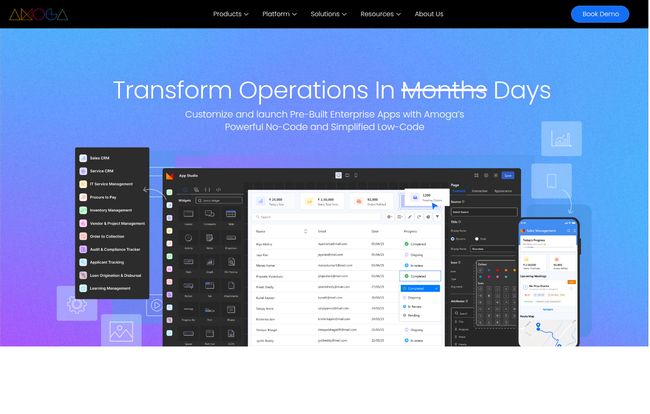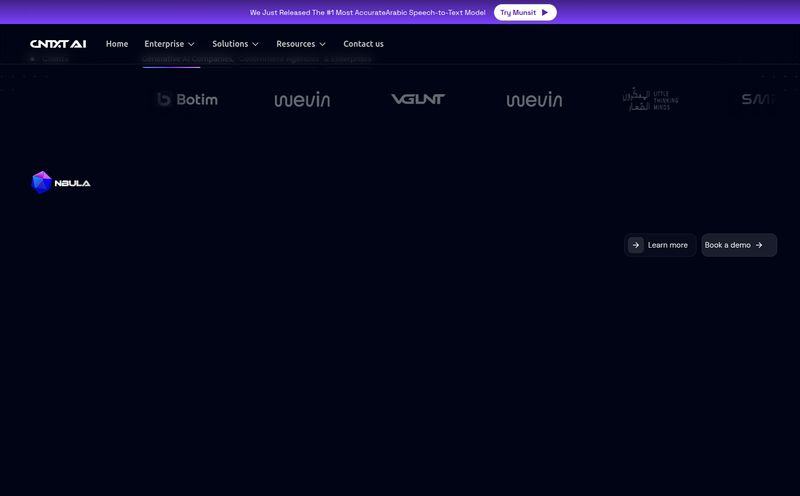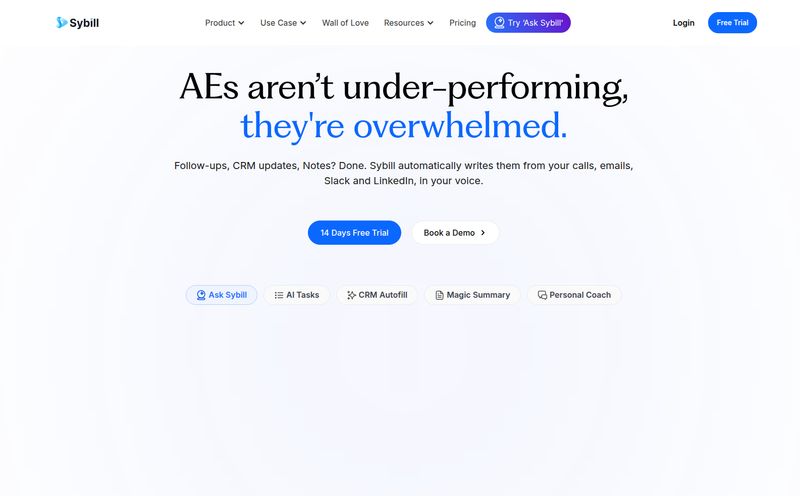Take a look at your company’s bookmarks bar. How many different SaaS logins are there? You’ve got one for sales, another for customer support, a third for project management, and maybe a couple more for HR and finance that you only remember when it's time to approve expenses. It's a digital Frankenstein's monster of subscriptions, and we call it “SaaS sprawl.” It’s expensive, it’s messy, and honestly, it’s a productivity killer. I’ve been in this game for years, and I’ve seen companies get absolutely buried under the weight of their own tools.
Every so often, a platform comes along that promises to be the cure. The one platform to rule them all. Today, we’re looking at one of those contenders: Amoga. Their homepage hits you with a big promise: “Transform Operations in Months Days.” (I'm guessing they mean 'in days, not months', but hey, we all make typos). So, is it just another shiny object, or could it actually be the streamlined command center your business needs? Let's get into it.
So, What Exactly Is Amoga Anyway?
Before we go any further, let's clear up the jargon. Amoga is a low-code platform. Think of it like a set of super-powered LEGOs for building business applications. Instead of writing thousands of lines of code from scratch (the old way), you get pre-built, customizable blocks that you can snap together with a drag-and-drop interface. You can build what you need, fast.
Amoga takes this a step further by not just giving you the blocks, but also providing pre-built apps for common business functions. We’re talking about things like:
- Sales CRM
- Service CRM & IT Service Management
- Real Estate & D2C Management
- Finance and HR tools (Expense Management, Onboarding, etc.)
The whole idea is to stop the madness of paying for ten different tools that don’t talk to each other and, instead, build or customize your own solutions on one unified platform. It’s an ambitious goal, but one that gets my SEO-and-efficiency-loving heart beating a little faster.

Visit Amoga
My First Impressions: The Amoga Experience
The website talks a big game about “No-code simplicity” and being “Effortlessly intuitive.” I’m naturally skeptical of marketing speak, but the interface shown looks clean. It’s designed for operational teams—the people who are actually in the trenches doing the work—not just for hardcore developers. This is a smart move. If the people who need the tool can't use it, it's just shelfware.
The promise is that you can quickly design, deploy, and scale your applications. This means if your sales team suddenly needs a new way to track a specific type of lead, you don’t have to submit a ticket to IT and wait six months. In theory, you could build and launch that new process yourself in a fraction of the time. That’s the kind of agility that separates fast-moving companies from their slower competitors.
The Core Features That Actually Matter
Okay, let's break down the engine under the hood. What makes Amoga tick? It's more than just a pretty dashboard.
From Scattered Apps to a Unified Hub
This is the main event. The core value proposition of Amoga is consolidation. Instead of your customer data living in a silo in your service desk, completely separate from your sales CRM, Amoga aims to bring it all under one roof. When your entire team is working from a single source of truth, collaboration becomes smoother and insights become clearer. You stop having those “wait, which system is the correct one?” arguments. A single, cost-effecient platform is a huge plus.
Building at the Speed of Business
Rapid deployment isn't just a buzzword; it's a competitive advantage. The world changes fast, and businesses need to adapt. Amoga’s library of pre-built enterprise apps for industries from Ed Tech to Healthcare and Manufacturing means you’re not starting from zero. You’re starting on third base. This dramatically cuts down development time and gets powerful tools into the hands of your team when they need them, not a year later.
Data That Actually Tells a Story
I love data, but I hate useless data. You know what I mean—dashboards full of vanity metrics that look impressive but don’t tell you what to do next. Amoga boasts “Powerful Analytics,” with real-time, actionable insights. This means you can track performance, identify bottlenecks, and make informed decisions on the fly. When your analytics are tied directly to your operations within the same platform, the feedback loop is instant. You can see the impact of your changes as they happen.
The Good, The Bad, and The Complicated
No tool is perfect. As a professional, I think it's crucial to look at both sides of the coin. Here’s my honest breakdown of where Amoga shines and where you might hit a few bumps.
| The Wins (Pros) | The Hurdles (Cons) |
|---|---|
| Insanely fast deployment of apps. | Customization can be limited by pre-built components. |
| Agility to respond to business needs instantly. | Potential learning curve for non-technical users. |
| Cost-effective scalability and maintenance. | Integrating with very old, highly custom legacy systems could be tricky. |
Why You Might Genuinely Love Amoga
The speed is the real killer feature here. Imagine your Head of Service says, “We need a better way to manage warranty claims, and we need it last week.” With traditional development, you'd be looking at a multi-month project. With Amoga, you could potentially customize their Service CRM module and have a working solution in days. That’s not just an improvement; it's a total game-changer for operations. The cost savings from consolidating your SaaS stack and reducing maintenance overhead are also nothing to sneeze at.
Where You Might Stumble
Let's be realistic. The trade-off for speed and simplicity is sometimes a lack of infinite customisation. Because you're using pre-built components, you might not be able to tweak every single pixel and function to your exact, peculiar specification. For 95% of businesses, this is fine. But if you have a deeply entrenched, unique process that cannot be changed, you might feel a bit constrained. Also, while it’s “low-code,” it’s not “no-thought.” There will be a learning curve, especially for team members who are used to having tools that do just one thing.
Who Is Amoga Really For?
So who is the ideal customer for Amoga? I don't see this as a tool for a solo freelancer or a tiny startup. It's built for established businesses, probably in the small-to-medium enterprise (SME) or even enterprise department level, who are feeling the growing pains of operational chaos.
It’s for the Operations Manager who is tired of being a professional data-importer between five different systems. It's for the IT Director who wants to empower departments to build their own solutions without creating a security nightmare. And it’s definitely for the CEO or founder who looks at their monthly credit card statement and wonders why they’re paying so much for so many different pieces of software.
What's the Damage? A Look at Amoga's Pricing
This is the million-dollar question, right? Or, hopefully, a lot less. If you go looking for a pricing page on Amoga's website, you won't find one. Don't panic. This is actually very common for enterprise-grade platforms.
The pricing is almost certainly based on your specific needs: the number of users, the specific apps you want to deploy, the level of support you need, and the complexity of your integrations. It’s not a one-size-fits-all product. My advice? Don't let the lack of a pricing page scare you away. Use their “Book Demo” button. That’s the best way to get a real, no-nonsense quote tailored to your company's actual requirements.
Conclusion: Is Amoga the Answer to Your Operational Prayers?
After looking everything over, I have to say, I'm optimistic about what Amoga is doing. It’s tackling a very real, very painful problem that plagues so many growing businesses. The dream of a single, unified platform where all your operations can live in harmony is a powerful one.
Amoga seems to be a strong contender, especially for businesses that prioritize speed, agility, and consolidation over deep, from-the-ground-up customization. It’s a trade off, for sure, but one that I think will be worth it for many. It's not magic, but it's a practical and powerful approach to taming the operational beast. If you're drowning in a sea of SaaS subscriptions, Amoga is definitely worth a closer look.
Frequently Asked Questions
What is a low-code platform?
A low-code platform allows users to create applications using visual development tools like drag-and-drop interfaces instead of writing traditional, line-by-line code. This makes app development faster and more accessible to people without deep programming knowledge.
What kind of businesses can use Amoga?
Amoga is designed for a wide range of industries, including Ed Tech, Healthcare, Lending, BFSI, D2C, Manufacturing, and more. It’s best suited for small to medium-sized enterprises (SMEs) and larger corporate departments looking to streamline their operations.
Can Amoga replace my existing CRM and service desk software?
Yes, that's one of its primary goals. Amoga offers pre-built, customizable modules like Sales CRM and Service CRM that are designed to replace standalone applications, allowing you to manage all your customer interactions on a single platform.
Is Amoga difficult to learn?
While it's designed to be intuitive for operational teams, any powerful new platform will have a learning curve. Because it's a low-code platform, it's significantly easier to learn than traditional programming, but users should expect to invest some time to understand how to build and customize apps effectively.
How does Amoga handle integrations with other software?
Amoga is built for “seamless integrations,” meaning it's designed to connect with your existing tools and data sources. This allows you to pull data from other systems and automate workflows across your entire tech stack, though complex integrations with legacy systems might require more setup.
Does Amoga have a mobile app?
Yes, the footer of their website includes a link to the Google Play Store, indicating they have an Android app available so your team can manage operations on the go.



